Report: Identification of Network Security Threats at University
VerifiedAdded on 2022/10/10
|8
|1416
|316
Report
AI Summary
This report focuses on identifying and addressing network security threats within a university environment. It begins by categorizing common threats such as viruses, DDoS attacks, and phishing emails. The report then provides recommendations for securing both wired and wireless networks, including the use of VLANs, VPNs, strong encryption, and firewalls. It also discusses methods for securing Windows and UNIX operating systems through security patches, malware removal tools, and firewalls. Furthermore, the report outlines identification, authentication, and access control mechanisms, such as network security policies, two-factor authentication, and automated systems for fraud detection. The potential consequences of neglecting these security measures, including data breaches and reputational damage, are also highlighted. The report concludes by summarizing key threats and solutions, emphasizing the importance of proactive security measures for protecting the university's network and data.
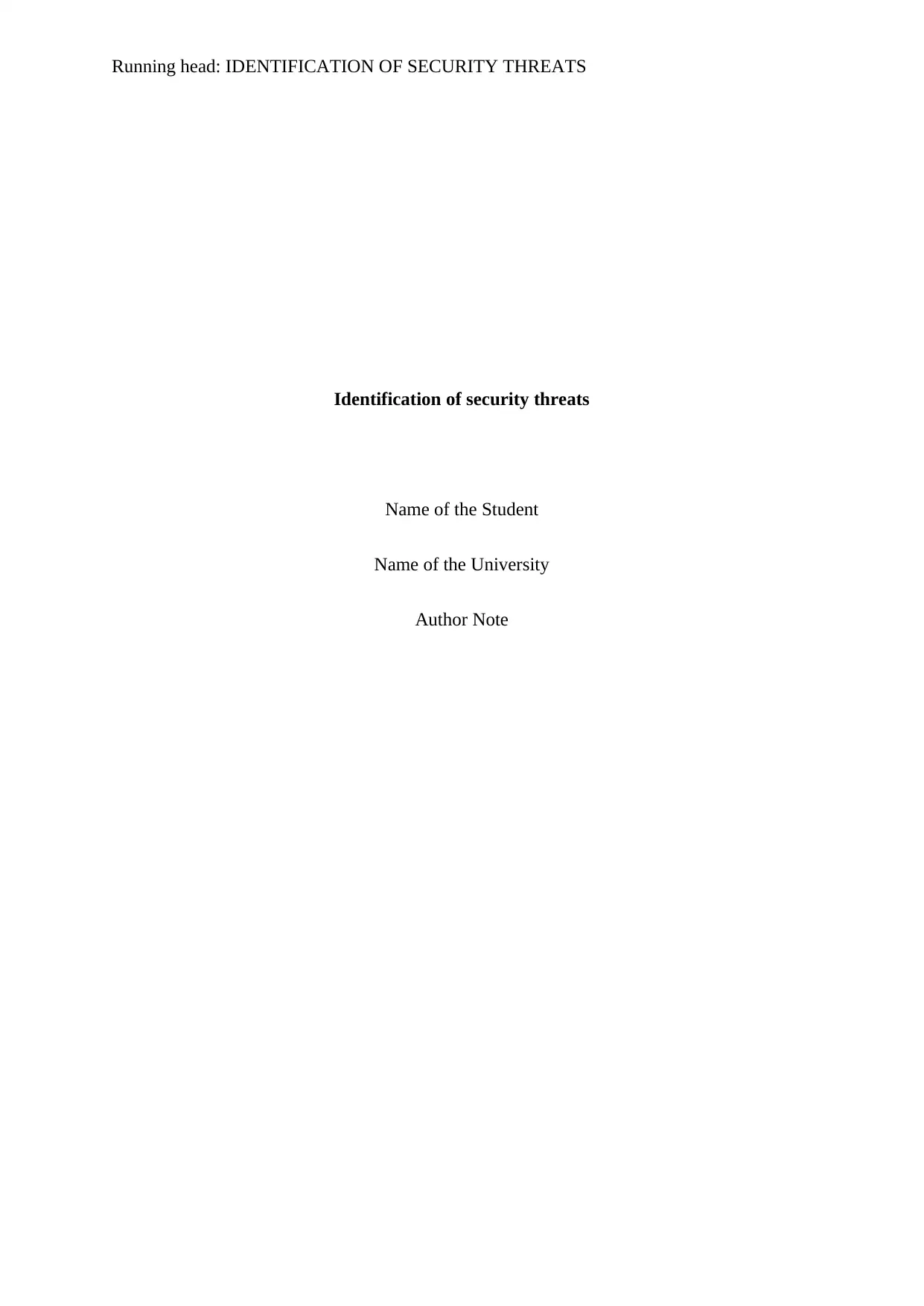
Running head: IDENTIFICATION OF SECURITY THREATS
Identification of security threats
Name of the Student
Name of the University
Author Note
Identification of security threats
Name of the Student
Name of the University
Author Note
Paraphrase This Document
Need a fresh take? Get an instant paraphrase of this document with our AI Paraphraser
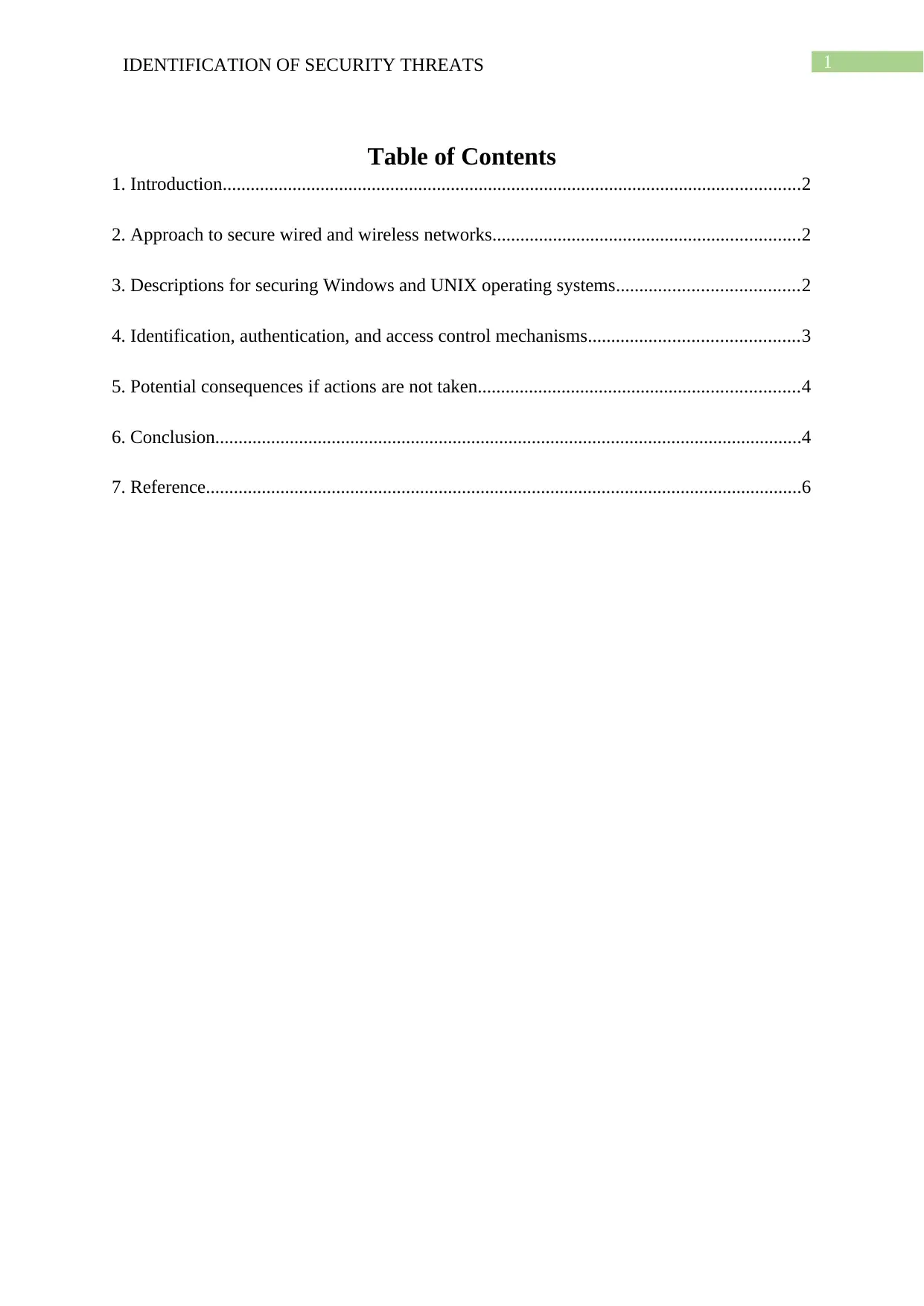
1IDENTIFICATION OF SECURITY THREATS
Table of Contents
1. Introduction............................................................................................................................2
2. Approach to secure wired and wireless networks..................................................................2
3. Descriptions for securing Windows and UNIX operating systems.......................................2
4. Identification, authentication, and access control mechanisms.............................................3
5. Potential consequences if actions are not taken.....................................................................4
6. Conclusion..............................................................................................................................4
7. Reference................................................................................................................................6
Table of Contents
1. Introduction............................................................................................................................2
2. Approach to secure wired and wireless networks..................................................................2
3. Descriptions for securing Windows and UNIX operating systems.......................................2
4. Identification, authentication, and access control mechanisms.............................................3
5. Potential consequences if actions are not taken.....................................................................4
6. Conclusion..............................................................................................................................4
7. Reference................................................................................................................................6
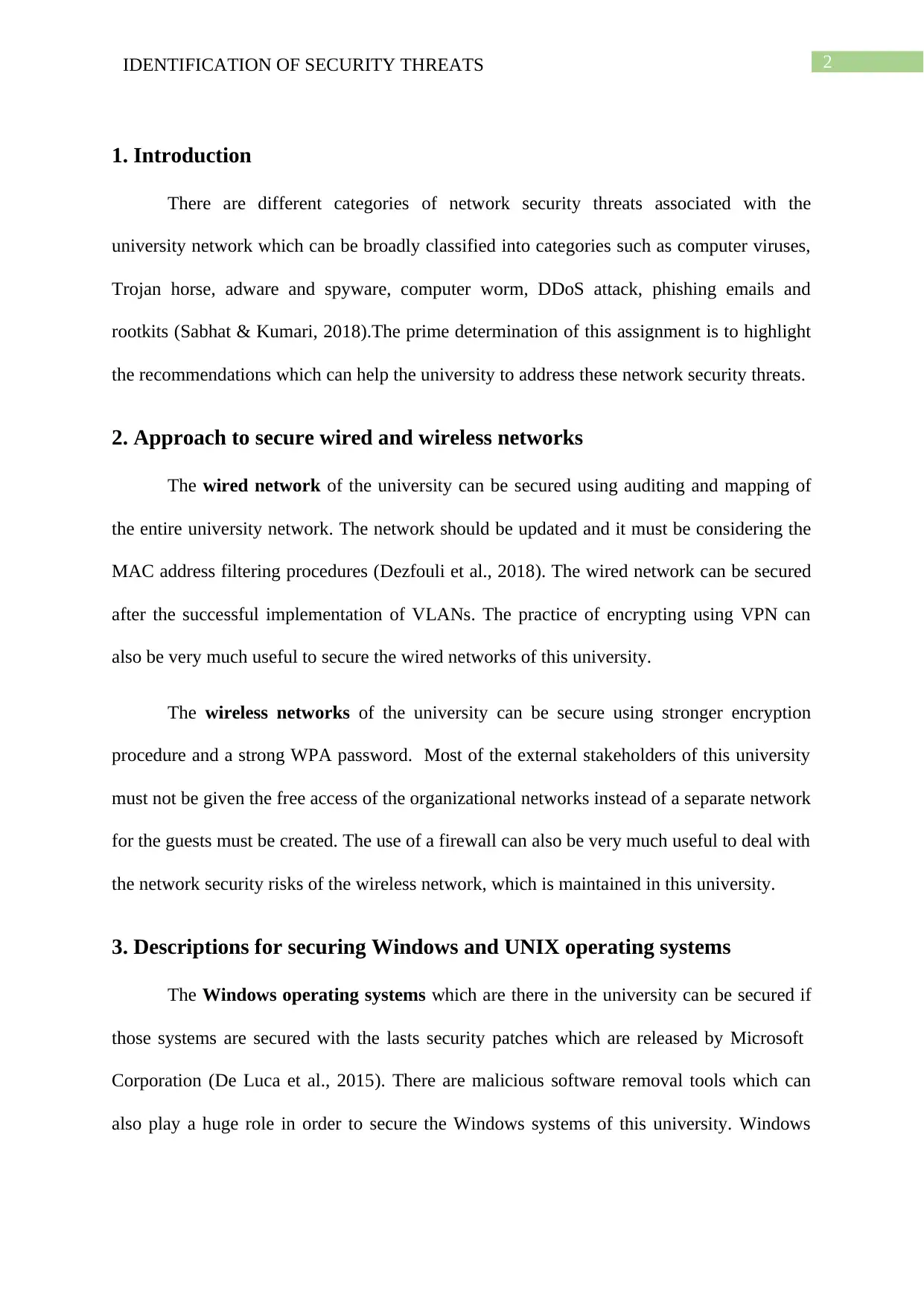
2IDENTIFICATION OF SECURITY THREATS
1. Introduction
There are different categories of network security threats associated with the
university network which can be broadly classified into categories such as computer viruses,
Trojan horse, adware and spyware, computer worm, DDoS attack, phishing emails and
rootkits (Sabhat & Kumari, 2018).The prime determination of this assignment is to highlight
the recommendations which can help the university to address these network security threats.
2. Approach to secure wired and wireless networks
The wired network of the university can be secured using auditing and mapping of
the entire university network. The network should be updated and it must be considering the
MAC address filtering procedures (Dezfouli et al., 2018). The wired network can be secured
after the successful implementation of VLANs. The practice of encrypting using VPN can
also be very much useful to secure the wired networks of this university.
The wireless networks of the university can be secure using stronger encryption
procedure and a strong WPA password. Most of the external stakeholders of this university
must not be given the free access of the organizational networks instead of a separate network
for the guests must be created. The use of a firewall can also be very much useful to deal with
the network security risks of the wireless network, which is maintained in this university.
3. Descriptions for securing Windows and UNIX operating systems
The Windows operating systems which are there in the university can be secured if
those systems are secured with the lasts security patches which are released by Microsoft
Corporation (De Luca et al., 2015). There are malicious software removal tools which can
also play a huge role in order to secure the Windows systems of this university. Windows
1. Introduction
There are different categories of network security threats associated with the
university network which can be broadly classified into categories such as computer viruses,
Trojan horse, adware and spyware, computer worm, DDoS attack, phishing emails and
rootkits (Sabhat & Kumari, 2018).The prime determination of this assignment is to highlight
the recommendations which can help the university to address these network security threats.
2. Approach to secure wired and wireless networks
The wired network of the university can be secured using auditing and mapping of
the entire university network. The network should be updated and it must be considering the
MAC address filtering procedures (Dezfouli et al., 2018). The wired network can be secured
after the successful implementation of VLANs. The practice of encrypting using VPN can
also be very much useful to secure the wired networks of this university.
The wireless networks of the university can be secure using stronger encryption
procedure and a strong WPA password. Most of the external stakeholders of this university
must not be given the free access of the organizational networks instead of a separate network
for the guests must be created. The use of a firewall can also be very much useful to deal with
the network security risks of the wireless network, which is maintained in this university.
3. Descriptions for securing Windows and UNIX operating systems
The Windows operating systems which are there in the university can be secured if
those systems are secured with the lasts security patches which are released by Microsoft
Corporation (De Luca et al., 2015). There are malicious software removal tools which can
also play a huge role in order to secure the Windows systems of this university. Windows
⊘ This is a preview!⊘
Do you want full access?
Subscribe today to unlock all pages.

Trusted by 1+ million students worldwide
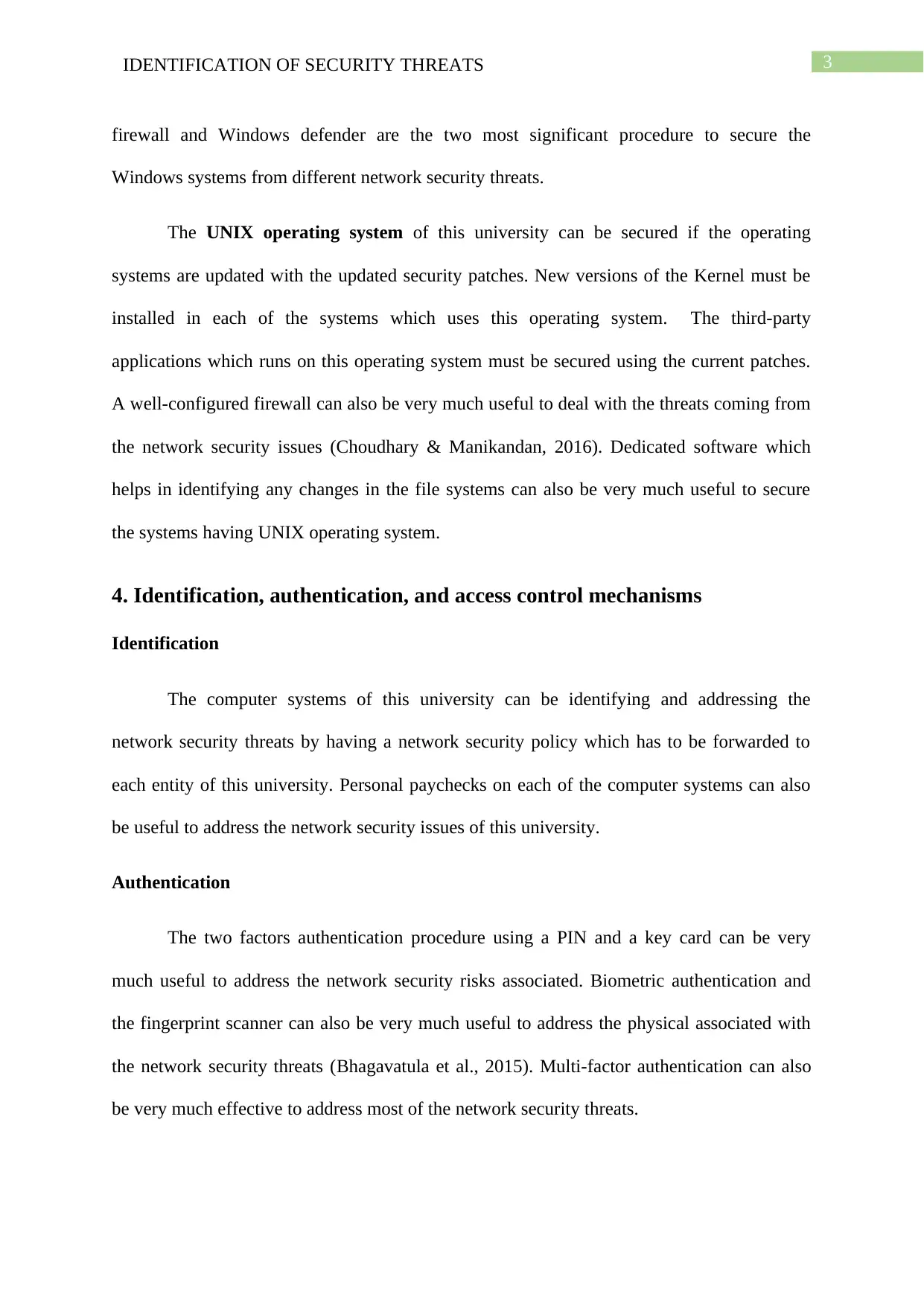
3IDENTIFICATION OF SECURITY THREATS
firewall and Windows defender are the two most significant procedure to secure the
Windows systems from different network security threats.
The UNIX operating system of this university can be secured if the operating
systems are updated with the updated security patches. New versions of the Kernel must be
installed in each of the systems which uses this operating system. The third-party
applications which runs on this operating system must be secured using the current patches.
A well-configured firewall can also be very much useful to deal with the threats coming from
the network security issues (Choudhary & Manikandan, 2016). Dedicated software which
helps in identifying any changes in the file systems can also be very much useful to secure
the systems having UNIX operating system.
4. Identification, authentication, and access control mechanisms
Identification
The computer systems of this university can be identifying and addressing the
network security threats by having a network security policy which has to be forwarded to
each entity of this university. Personal paychecks on each of the computer systems can also
be useful to address the network security issues of this university.
Authentication
The two factors authentication procedure using a PIN and a key card can be very
much useful to address the network security risks associated. Biometric authentication and
the fingerprint scanner can also be very much useful to address the physical associated with
the network security threats (Bhagavatula et al., 2015). Multi-factor authentication can also
be very much effective to address most of the network security threats.
firewall and Windows defender are the two most significant procedure to secure the
Windows systems from different network security threats.
The UNIX operating system of this university can be secured if the operating
systems are updated with the updated security patches. New versions of the Kernel must be
installed in each of the systems which uses this operating system. The third-party
applications which runs on this operating system must be secured using the current patches.
A well-configured firewall can also be very much useful to deal with the threats coming from
the network security issues (Choudhary & Manikandan, 2016). Dedicated software which
helps in identifying any changes in the file systems can also be very much useful to secure
the systems having UNIX operating system.
4. Identification, authentication, and access control mechanisms
Identification
The computer systems of this university can be identifying and addressing the
network security threats by having a network security policy which has to be forwarded to
each entity of this university. Personal paychecks on each of the computer systems can also
be useful to address the network security issues of this university.
Authentication
The two factors authentication procedure using a PIN and a key card can be very
much useful to address the network security risks associated. Biometric authentication and
the fingerprint scanner can also be very much useful to address the physical associated with
the network security threats (Bhagavatula et al., 2015). Multi-factor authentication can also
be very much effective to address most of the network security threats.
Paraphrase This Document
Need a fresh take? Get an instant paraphrase of this document with our AI Paraphraser
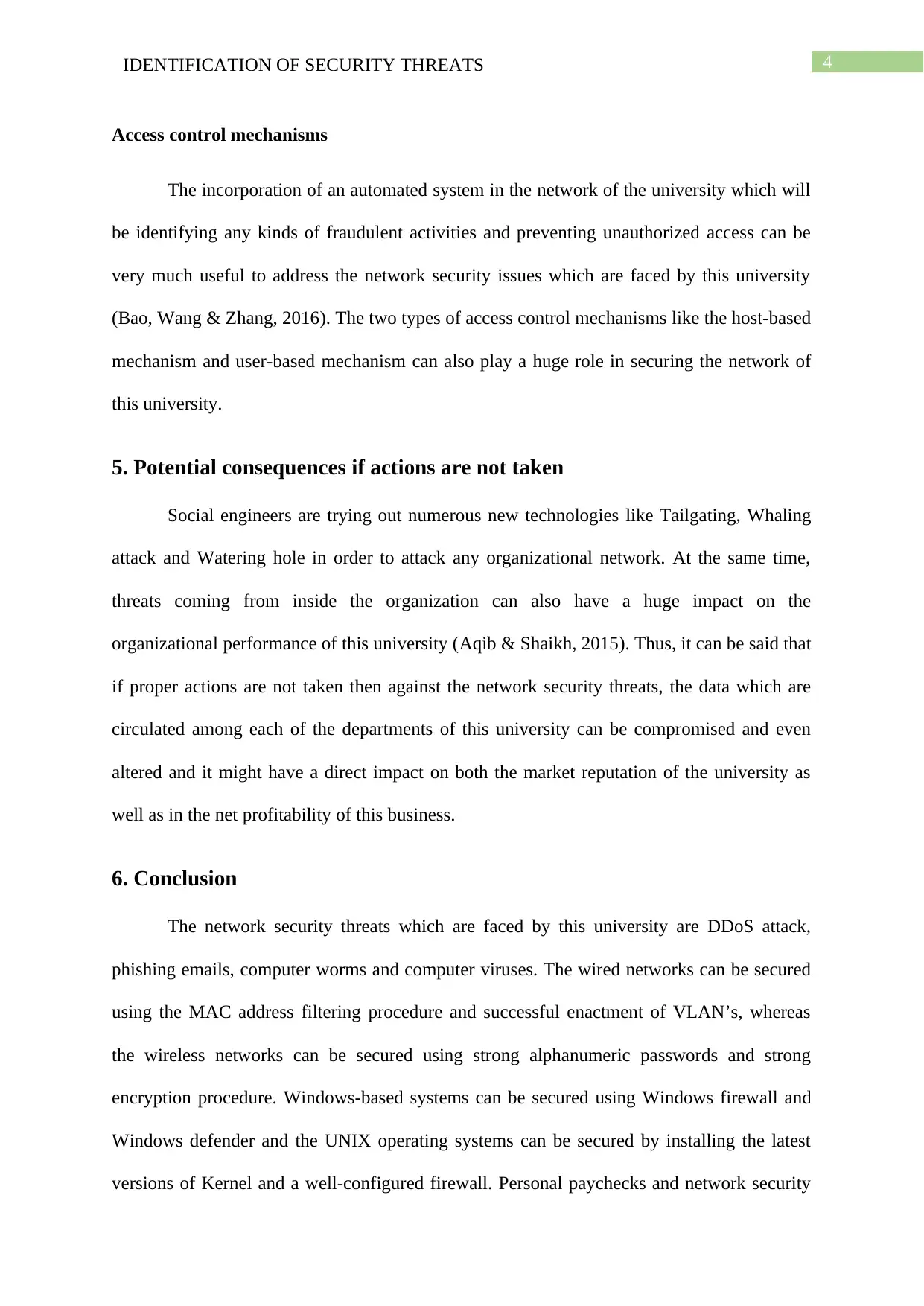
4IDENTIFICATION OF SECURITY THREATS
Access control mechanisms
The incorporation of an automated system in the network of the university which will
be identifying any kinds of fraudulent activities and preventing unauthorized access can be
very much useful to address the network security issues which are faced by this university
(Bao, Wang & Zhang, 2016). The two types of access control mechanisms like the host-based
mechanism and user-based mechanism can also play a huge role in securing the network of
this university.
5. Potential consequences if actions are not taken
Social engineers are trying out numerous new technologies like Tailgating, Whaling
attack and Watering hole in order to attack any organizational network. At the same time,
threats coming from inside the organization can also have a huge impact on the
organizational performance of this university (Aqib & Shaikh, 2015). Thus, it can be said that
if proper actions are not taken then against the network security threats, the data which are
circulated among each of the departments of this university can be compromised and even
altered and it might have a direct impact on both the market reputation of the university as
well as in the net profitability of this business.
6. Conclusion
The network security threats which are faced by this university are DDoS attack,
phishing emails, computer worms and computer viruses. The wired networks can be secured
using the MAC address filtering procedure and successful enactment of VLAN’s, whereas
the wireless networks can be secured using strong alphanumeric passwords and strong
encryption procedure. Windows-based systems can be secured using Windows firewall and
Windows defender and the UNIX operating systems can be secured by installing the latest
versions of Kernel and a well-configured firewall. Personal paychecks and network security
Access control mechanisms
The incorporation of an automated system in the network of the university which will
be identifying any kinds of fraudulent activities and preventing unauthorized access can be
very much useful to address the network security issues which are faced by this university
(Bao, Wang & Zhang, 2016). The two types of access control mechanisms like the host-based
mechanism and user-based mechanism can also play a huge role in securing the network of
this university.
5. Potential consequences if actions are not taken
Social engineers are trying out numerous new technologies like Tailgating, Whaling
attack and Watering hole in order to attack any organizational network. At the same time,
threats coming from inside the organization can also have a huge impact on the
organizational performance of this university (Aqib & Shaikh, 2015). Thus, it can be said that
if proper actions are not taken then against the network security threats, the data which are
circulated among each of the departments of this university can be compromised and even
altered and it might have a direct impact on both the market reputation of the university as
well as in the net profitability of this business.
6. Conclusion
The network security threats which are faced by this university are DDoS attack,
phishing emails, computer worms and computer viruses. The wired networks can be secured
using the MAC address filtering procedure and successful enactment of VLAN’s, whereas
the wireless networks can be secured using strong alphanumeric passwords and strong
encryption procedure. Windows-based systems can be secured using Windows firewall and
Windows defender and the UNIX operating systems can be secured by installing the latest
versions of Kernel and a well-configured firewall. Personal paychecks and network security
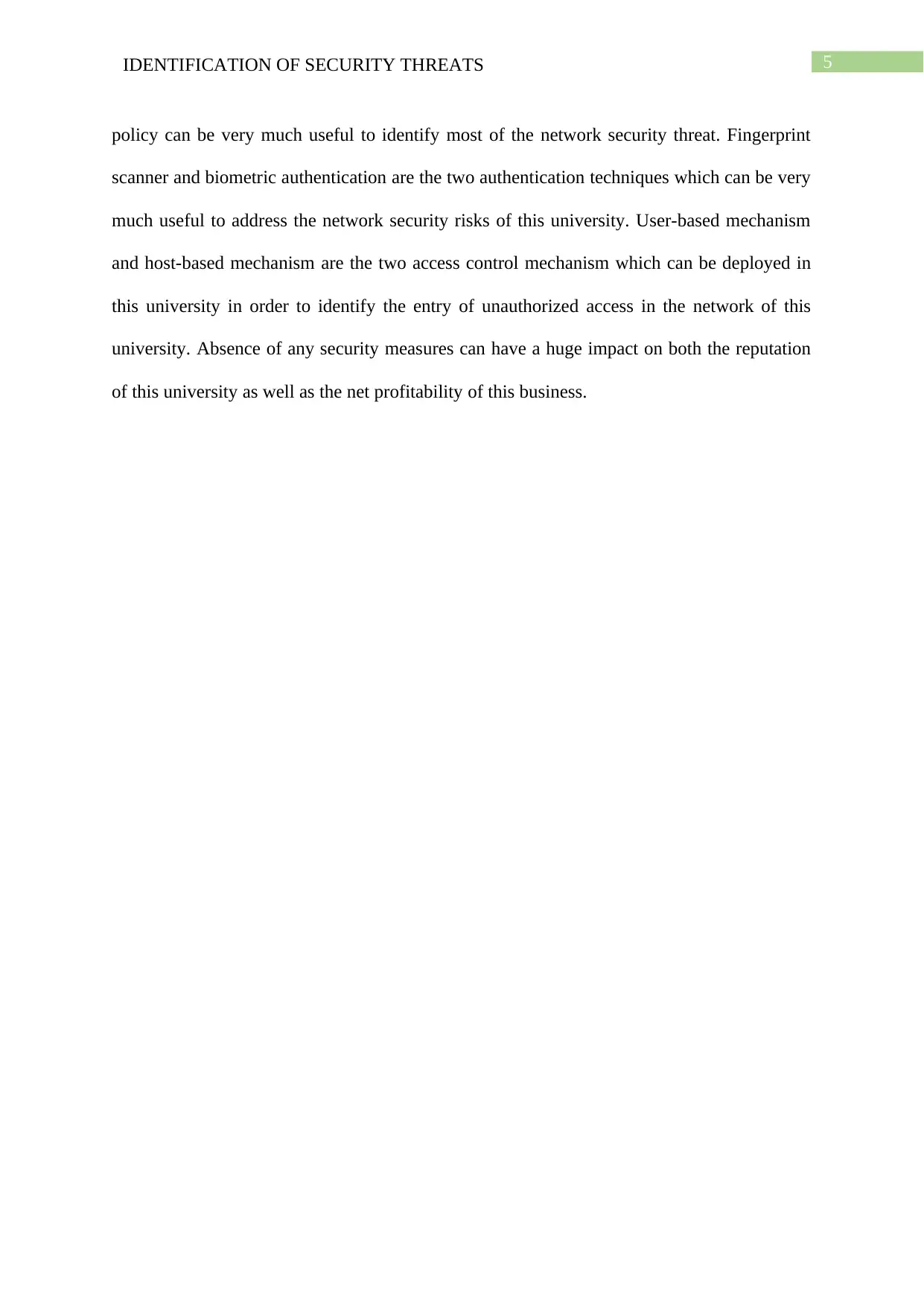
5IDENTIFICATION OF SECURITY THREATS
policy can be very much useful to identify most of the network security threat. Fingerprint
scanner and biometric authentication are the two authentication techniques which can be very
much useful to address the network security risks of this university. User-based mechanism
and host-based mechanism are the two access control mechanism which can be deployed in
this university in order to identify the entry of unauthorized access in the network of this
university. Absence of any security measures can have a huge impact on both the reputation
of this university as well as the net profitability of this business.
policy can be very much useful to identify most of the network security threat. Fingerprint
scanner and biometric authentication are the two authentication techniques which can be very
much useful to address the network security risks of this university. User-based mechanism
and host-based mechanism are the two access control mechanism which can be deployed in
this university in order to identify the entry of unauthorized access in the network of this
university. Absence of any security measures can have a huge impact on both the reputation
of this university as well as the net profitability of this business.
⊘ This is a preview!⊘
Do you want full access?
Subscribe today to unlock all pages.

Trusted by 1+ million students worldwide
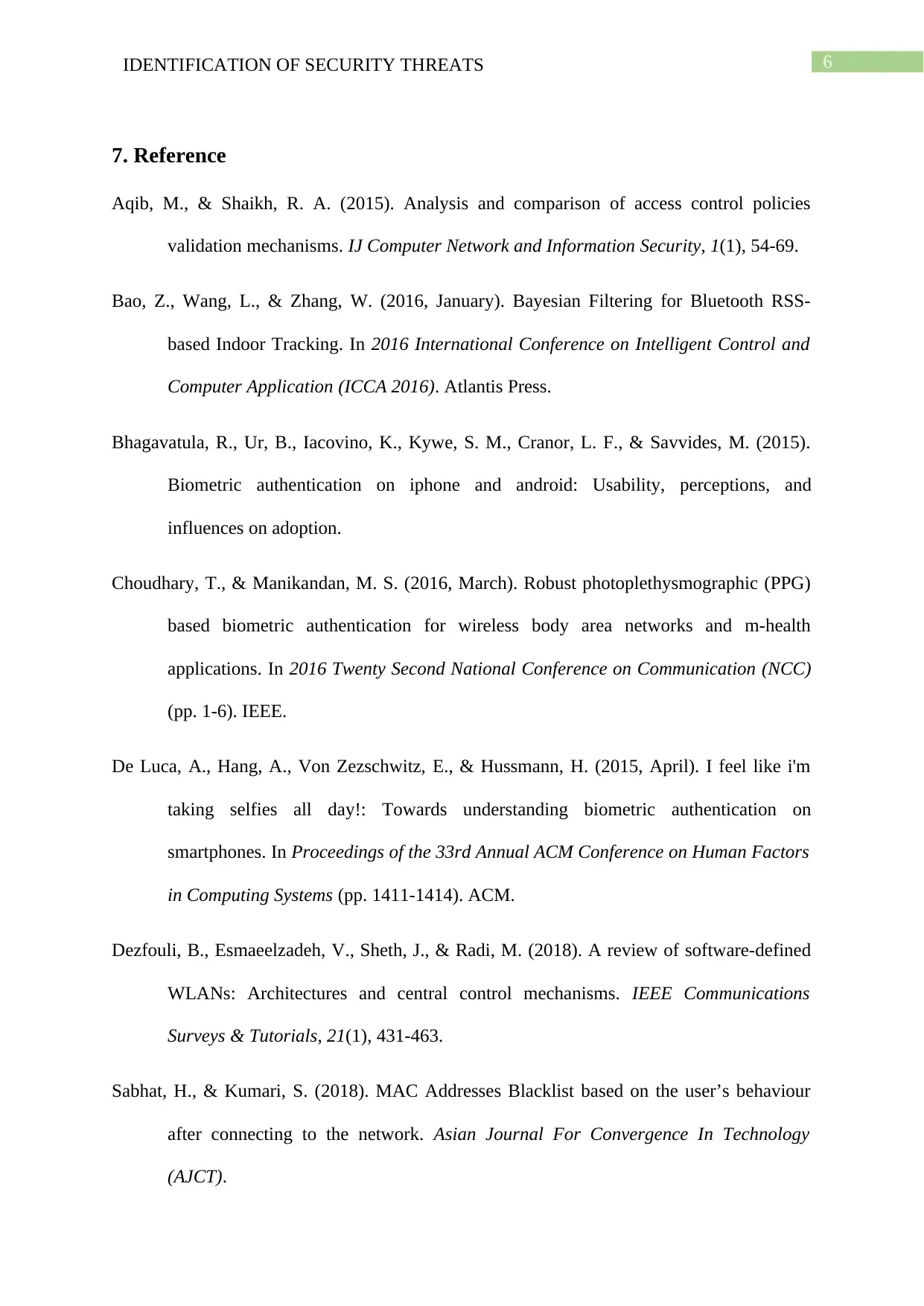
6IDENTIFICATION OF SECURITY THREATS
7. Reference
Aqib, M., & Shaikh, R. A. (2015). Analysis and comparison of access control policies
validation mechanisms. IJ Computer Network and Information Security, 1(1), 54-69.
Bao, Z., Wang, L., & Zhang, W. (2016, January). Bayesian Filtering for Bluetooth RSS-
based Indoor Tracking. In 2016 International Conference on Intelligent Control and
Computer Application (ICCA 2016). Atlantis Press.
Bhagavatula, R., Ur, B., Iacovino, K., Kywe, S. M., Cranor, L. F., & Savvides, M. (2015).
Biometric authentication on iphone and android: Usability, perceptions, and
influences on adoption.
Choudhary, T., & Manikandan, M. S. (2016, March). Robust photoplethysmographic (PPG)
based biometric authentication for wireless body area networks and m-health
applications. In 2016 Twenty Second National Conference on Communication (NCC)
(pp. 1-6). IEEE.
De Luca, A., Hang, A., Von Zezschwitz, E., & Hussmann, H. (2015, April). I feel like i'm
taking selfies all day!: Towards understanding biometric authentication on
smartphones. In Proceedings of the 33rd Annual ACM Conference on Human Factors
in Computing Systems (pp. 1411-1414). ACM.
Dezfouli, B., Esmaeelzadeh, V., Sheth, J., & Radi, M. (2018). A review of software-defined
WLANs: Architectures and central control mechanisms. IEEE Communications
Surveys & Tutorials, 21(1), 431-463.
Sabhat, H., & Kumari, S. (2018). MAC Addresses Blacklist based on the user’s behaviour
after connecting to the network. Asian Journal For Convergence In Technology
(AJCT).
7. Reference
Aqib, M., & Shaikh, R. A. (2015). Analysis and comparison of access control policies
validation mechanisms. IJ Computer Network and Information Security, 1(1), 54-69.
Bao, Z., Wang, L., & Zhang, W. (2016, January). Bayesian Filtering for Bluetooth RSS-
based Indoor Tracking. In 2016 International Conference on Intelligent Control and
Computer Application (ICCA 2016). Atlantis Press.
Bhagavatula, R., Ur, B., Iacovino, K., Kywe, S. M., Cranor, L. F., & Savvides, M. (2015).
Biometric authentication on iphone and android: Usability, perceptions, and
influences on adoption.
Choudhary, T., & Manikandan, M. S. (2016, March). Robust photoplethysmographic (PPG)
based biometric authentication for wireless body area networks and m-health
applications. In 2016 Twenty Second National Conference on Communication (NCC)
(pp. 1-6). IEEE.
De Luca, A., Hang, A., Von Zezschwitz, E., & Hussmann, H. (2015, April). I feel like i'm
taking selfies all day!: Towards understanding biometric authentication on
smartphones. In Proceedings of the 33rd Annual ACM Conference on Human Factors
in Computing Systems (pp. 1411-1414). ACM.
Dezfouli, B., Esmaeelzadeh, V., Sheth, J., & Radi, M. (2018). A review of software-defined
WLANs: Architectures and central control mechanisms. IEEE Communications
Surveys & Tutorials, 21(1), 431-463.
Sabhat, H., & Kumari, S. (2018). MAC Addresses Blacklist based on the user’s behaviour
after connecting to the network. Asian Journal For Convergence In Technology
(AJCT).
Paraphrase This Document
Need a fresh take? Get an instant paraphrase of this document with our AI Paraphraser

7IDENTIFICATION OF SECURITY THREATS
1 out of 8
Related Documents
Your All-in-One AI-Powered Toolkit for Academic Success.
+13062052269
info@desklib.com
Available 24*7 on WhatsApp / Email
![[object Object]](/_next/static/media/star-bottom.7253800d.svg)
Unlock your academic potential
Copyright © 2020–2025 A2Z Services. All Rights Reserved. Developed and managed by ZUCOL.




